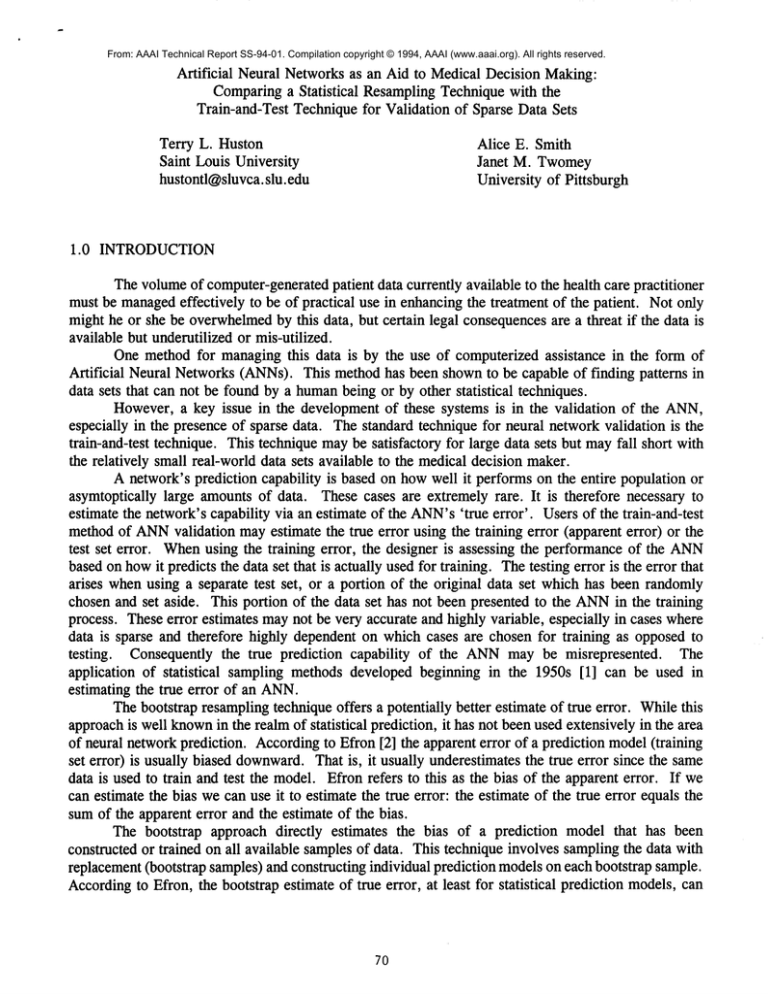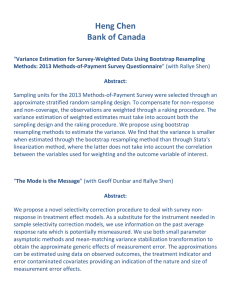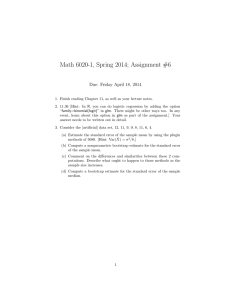
From: AAAI Technical Report SS-94-01. Compilation copyright © 1994, AAAI (www.aaai.org). All rights reserved.
Artificial Neural Networks as an Aid to Medical Decision Making:
Comparinga Statistical Resampling Technique with the
Train-and-Test Technique for Validation of Sparse Data Sets
Terry L. Huston
Saint Louis University
hustontl@sluvca,slu. edu
1.0
Alice E. Smith
Janet M. Twomey
University of Pittsburgh
INTRODUCTION
Thevolumeof computer-generatedpatient data currently available to the health care practitioner
must be managedeffectively to be of practical use in enhancingthe treatment of the patient. Not only
might he or she be overwhelmed
by this data, but certain legal consequencesare a threat if the data is
available but underutilized or mis-utilized.
One method for managingthis data is by the use of computerized assistance in the form of
Artificial Neural Networks(ANNs).This methodhas been shownto be capable of finding patterns
data sets that can not be found by a humanbeing or by other statistical techniques.
However,a key issue in the development of these systems is in the validation of the ANN,
especially in the presence of sparse data. The standard technique for neural network validation is the
train-and-test technique. This technique maybe satisfactory for large data sets but mayfall short with
the relatively small real-world data sets available to the medical decision maker.
A network’s prediction capability is based on howwell it performs on the entire population or
asymtoptically large amountsof data. These cases are extremely rare. It is therefore necessary to
estimate the network’s capability via an estimate of the ANN’s’true error’. Users of the train-and-test
methodof ANNvalidation mayestimate the true error using the training error (apparent error) or the
test set error. Whenusing the training error, the designer is assessing the performance of the ANN
based on howit predicts the data set that is actually used for training. Thetesting error is the error that
arises whenusing a separate test set, or a portion of the original data set which has been randomly
chosen and set aside. This portion of the data set has not been presented to the ANNin the training
process. These error estimates maynot be very accurate and highly variable, especially in cases where
data is sparse and therefore highly dependent on which cases are chosen for training as opposed to
testing. Consequently the true prediction capability of the ANNmay be misrepresented. The
application of statistical
sampling methods developed beginning in the 1950s [1] can be used in
estimating the true error of an ANN.
The bootstrap resampling technique offers a potentially better estimate of true error. Whilethis
approachis well knownin the realm of statistical prediction, it has not been used extensively in the area
of neural networkprediction. Accordingto Efron [2] the apparent error of a prediction model(training
set error) is usually biased downward.That is, it usually underestimates the true error since the same
data is used to train and test the model. Efron refers to this as the bias of the apparent error. If we
can estimate the bias wecan use it to estimate the true error: the estimate of the true error equals the
sumof the apparent error and the estimate of the bias.
The bootstrap approach directly estimates the bias of a prediction model that has been
constructed or trained on all available samples of data. This technique involves sampling the data with
replacement(bootstrap samples) and constructing individual prediction modelson each bootstrap sample.
Accordingto Efron, the bootstrap estimate of true error, at least for statistical prediction models,can
7O
be biased but is less variable. Future research is neededto offer a general groundingfor the application
of this technique to ANNs.Theadvantageto the use of this technique is in utilizing the entire data set
which is important whenconfronted with sparse data sets.
Utilization of these resampling methodsis computationally expensive. But this cost is justified
in manycases whereit is necessary to provide an increased accuracy, as well as low variability, of true
error estimate and increased confidence in the performance of the final ANNmodel. Whereas, these
methods increase the time involved in the development of an ANNsimulation, once an effective
simulation is discovered for a specific decision-making problem, the simulation maybe programmed
into a computerchip and utilized as a hand-held device capable of relatively ’real time’ problemsolving
assistance. Prior to the expenditure of funds to develop such a chip, the described validation techniques
can decrease the risk of developing a problematic chip.
2.0
METHODOLOGY
The data set used in this study involves predicting the amountof impraminebinding in platelets
of children from five measures of the child’s aggressive and/or impulsive behavior as determined by
the Child Behavior Checklist (CBCL).The five measures include Total Behavior Scores, Externalizing
Scores, Hostility Scores, Aggression Scores, and a Composite Scale [3]. There are a total of 23
subjects.
All networks are constructed of 5 input nodes for each CBCLmeasure (all continuous values),
1 layer of 3 hidden nodes, and one output node for the continuous valued impraminebinding count.
A learning rate of 1.0 and a smoothingfactor of 0.9 is used. All networks terminate at 10,000 passes
through the entire data set. All networks to be evaluated are from the feedforward, fully-connected,
class of networks utilizing backpropagation. Each of the networks used for comparison starts with
identical randomweights. Brainmakeris used for all networks.
The standard train-and-test
method of ANNdevelopment and evaluation is compared to the
bootstrap resampling technique. Initially, the data set is shuffled and divided randomly, withholding
20%for a separate test set. The remaining 80%are used to train the network. This trained network
is set aside after testing, the data set is recombined,shuffled, and is again separated randomlyinto 80%
training set and 20%testing set, and the train-and-test is repeated for the newnetwork. This is repeated
for a total of 5 separate trained and tested networks. The sameprocedure is then repeated, separating
the data set into 60%training and 40%testing sets. This results in a total of 10 independentlytrained
and tested networks.
Thebootstrap resamplingtechnique is then used as an alternative approachto estimating the true
error of a neural network prediction model. A total of 100 bootstrap samples are constructed from the
total sample of 23 subjects. Each bootstrap sample contains 23 samples (randomly sampled) and
sampled with replacement from the original sample of 23 subjects. All networks are trained according
to the methoddescribed above.
3.0
RESULTS
The results are shown in Table One. Each of the 10 ANNsis evaluated by assessing the Mean
Squared Error (MSE)and the MeanAbsolute Error (MAE)of both the training set (apparent error)
the testing set. The networks are numbered1 through 10. The first five utilize a 20%test set and an
80%training set. Networks6 through 10 utilize a 40%test set and a 60%training set. The letter a
indicates the apparent error or testing on the training set. Theletter t indicates testing on the test set
for that particular network. The key item to note is the wide range of meanand standard deviation of
71
the results. Dependingon which of these networks is used for a ’final model’ affects the estimate of
the true error of the network.
Thebootstrap methodologyis used as an alternative approachto estimating the true error of the
network. The MSEand MAEof the final network (network trained on all 23 samples) are 12183.7 and
88.7, respectively. Thebias of this error according to the bootstrap is 21129.9using the MSEand 53.0
for the MAE.Therefore the bootstrap estimates of true MSEand true MAEare 33313.6 (12183.7
21129.9) and 141.7 (88.7 + 53.0), respectively.
4.0
DISCUSSION
As can be ascertained, the bootstrap resampling technique is quite computationallyintensive and
expensive. The standard train-and-test evaluation technique for ANNsmaybe satisfactory for large data
sets, and the added cost of utilizing a resampling technique might not be warranted. However,when
confronted with sparse data sets as frequently found in medical decision making, the added cost of
resampling results in the added benefit of a more robust validation methodologyfor an ANN.In the
case of ANNmodels used for patient management,bootstrap resampling likely improves the estimation
of the true error of the model.
The train-and-test methodologycan provide unbiased estimates of true error, but it does have
its limitations, especially with sparse data sets. Whenworkingwith a small data set, usually as much
of the data is used for training as possible, leaving a relatively small set for testing. In cases where
only small samples are available, training and testing maybe biased and highly variable according to
the sampleschosen for training and those chosen for testing. Further, since the data set is subdivided
randomly,replicating the results from the literature using the samedata is difficult.
Withthe computationally expensive costs involved with the bootstrap methodof validation, what
are the purported benefits? The primary objective of the model-building procedure is to design the
’best’ prediction model. To accomplish this, the model-building procedure must maximize our
confidence in the overall design and testing of the model. Underthe conditions of finite samplesize,
this translates into maximizingthe use of all sample points. The optimal use of data is the motivation
for the application of resampling methodologies;i.e., the final modelis constructed using all n data
points and the error of the final modelis estimated via resamplingof all n data points.
Resamplingtechniques in statistical model-building are used to select modelparameters and to
construct confidence intervals about a prediction. There are strong indications for this same type of
resampling application to ANNs.However,further research into the trade-off between the costs of
computational effort and the benefits (utilization of the entire sample in modelconstruction and more
accurate estimates of error) is indicated.
5.0
CONCLUSION
The methodology described herein is useful for improving the error estimate of ANNsfor
medical decision-making dependent on small sample sizes. The sheer volume of computer-generated
patient data available to the humanmedical decision makernecessitates the developmentof artificial
’assistants’ to help discover pertinent patterns in the large volumeof clinical data, both for medicaland
legal purposes.
In order to increase our confidencein artificial assistants, it is imperative to enhancethe error
estimation of the subsequent models. Wherea limited set of data is the only source of information for
the medical decision maker to make an accurate and reliable diagnosis or ’prediction’ of patient
condition, a robust assessment of model accuracy is of extreme importance.
72
TABLE ONE
NET#
MSE
MAE
NET#
MSE
MAE
la
2a
3a
4a
5.__aa
Mean
Std Dev
4670.5
17170.0
8177.8
4521.7
4413.5
7790.7
4897.9
51.5
87.1
66.9
50.0
45.5
60.2
15.3
It
2t
3t
4t
5t
Mean
Std Dev
27990.8
26755.6
24765.7
30634.4
11391.4
24307.6
6732.4
81.8
71.8
53.4
75.6
51.7
66.9
12.1
6a
7a
8a
9a
10a
Mean
Std Dev
23712.5
1051.0
8731.6
4355.1
1003.3
7770.7
8457.9
118.2
25.8
64.4
42.0
23.0
54.68
35.0
6t
7t
8t
9t
10t
Mean
Std Dev
15296.9
34888.6
22075.3
33922.4
41170.8
29470.8
9398.4
55.1
101.7
87.6
86.9
101.1
86.48
16.9
Bootstrap
12183.7
88.7
Bootstrap
(bias of)
21129.9
53.0
a = Apparenterror (training set error estimate)
t = Testing error (testing set error estimate)
BIBLIOGRAPHY
1. Mosier, C.I. (1951) Symposium:the need and the meansfor cross-validation. 1. problemand designs
of cross-validation. Education and Psychological Measurement,11, 5-11.
2. Efron, B. (1982). The jackknife,
Monograph, 38.
bootstrap,
and other resampling plans. SIAM NSF-CBMS,
3. Birmaher, B., Stanley, M., Greenhill, L., Twomey,J. Gavrilescu, A., and Rabinovich, H. (1990).
Platelet impraminebinding in children and adolescents with impulsive behavior, Journal of the
AmericanAcademyof Child Adolescent Psychiatry, 29:6.
73





